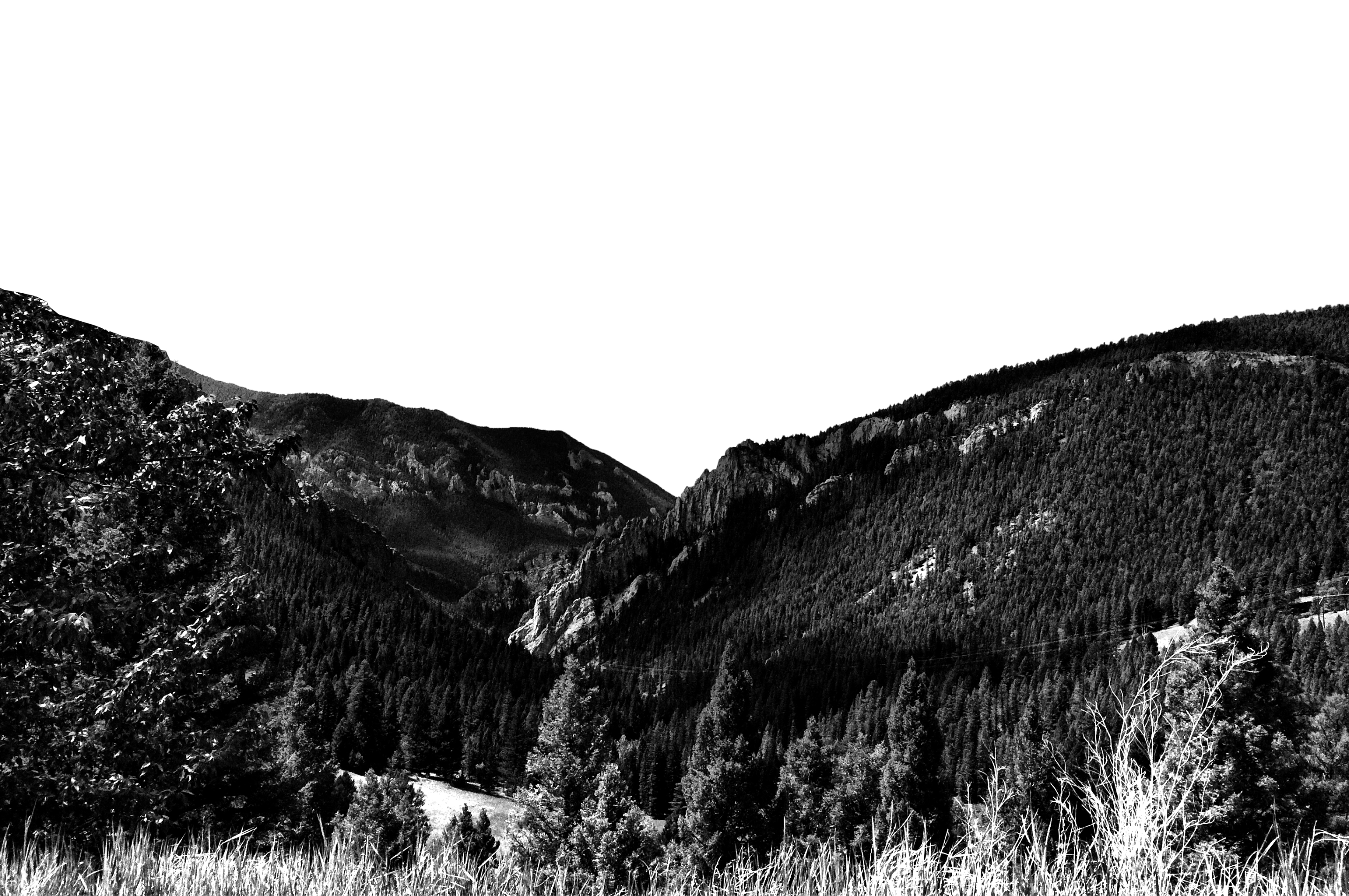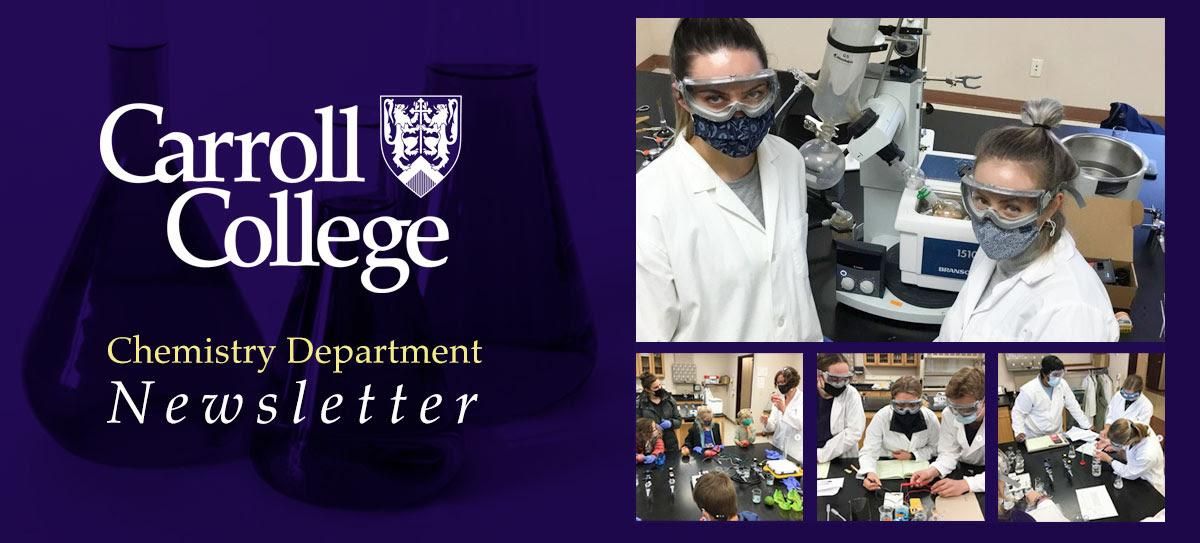Dear Carroll College Chemistry Alumni and Supporters:
The final days of winter have been warm and clear here in Helena, Montana. We hope you and your family are healthy and enjoying the lengthening daylight hours. We wanted to update you on what has been happening in our department this spring.
Carroll College's Mission Statement Reflected in the Diversity of Our Alumni
The Chemistry faculty embrace the Carroll College mission statement in our day-to-day work with students as their teachers, advisors, and lifelong supporters. We advance the mission of the college by “Welcoming all persons of good will in a cooperative journey toward truth and virtue.” This welcoming environment is reflected in the diversity of backgrounds, identities, goals, dreams, and ultimately vocations of the students we serve. We have a deep faith in all of the students we are blessed to serve.
Here are three recent Alumni Success articles highlighting some of the breadth in diversity welcomed and supported by department:
"My time at Carroll was one of great spiritual and intellectual growth. It was a time of awakening the desires in my heart. When I graduated with a degree in chemistry, I was sad to say goodbye to the wonderful professors, friends, and familiar surroundings, but I was ready for a great journey.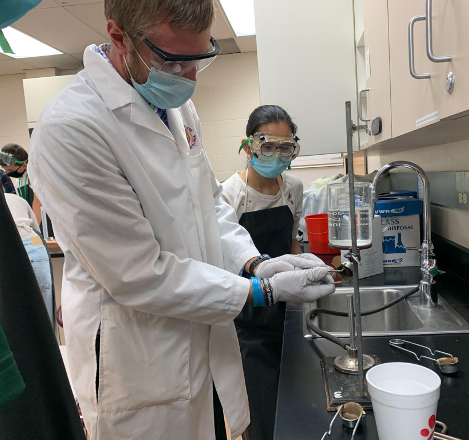
"As much as I enjoyed studying chemistry, I was ready to serve. This led me to Denver to work with people experiencing homelessness with Christ in the City. We spent our time in prayer and building relationships with our friends on the street. This eye-opening year gave me the courage to become a seminarian for the Diocese of Helena. For three years, I received many blessings and graces before discerning out to become a missionary again. Although this time, I headed to Peru to work with the Christian Life Movement, Focus, and other mission-oriented groups.
"Now, you might be thinking chemistry has become a thing of the past for me, but you would be wrong. After just over a year in Peru, I was invited to work as a teacher in my hometown. I taught middle school math and science, and for some reason, I really enjoyed teaching. Upon finding out the school was going to close, I entered a job search, and now have found myself in my second year of teaching high school chemistry at a small Catholic school in Denver (Bishop Machebeuf High School).
"It has been an honor to follow, in a small way, the professors who led me on such a great journey into reality with joy, faith, and hope. As I stand before my own students, inviting them to engage the world at the atomic level, I am inspired to share the many blessings and gifts I received from Carroll. I trust Carroll will continue to be a place of great formation for future scientists as they engage in an active curriculum and inspiring professors!" ~ Codi Kruger, Chemistry, Class of 2014
Haley Meredith graduated from Carroll College in 2019 with a B.A. in Biochemistry and Molecular Biology and a minor in Gender Studies. After graduation, Haley was proud to help deliver high-quality healthcare to women and gender minorities at Planned Parenthood of Montana in Helena as a clinic assistant.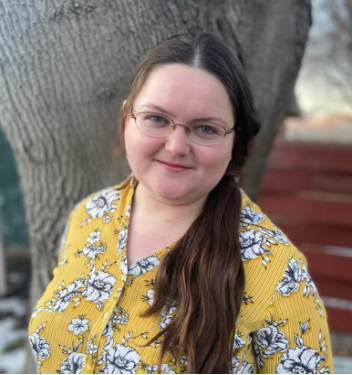
In the fall of 2021, she matriculated into the University of Montana’s Skaggs School of Pharmacy and continues to serve, now as a student pharmacist, at Missoula’s Planned Parenthood. Following her expected graduation in 2025, she looks forward to serving Montana communities as an ambulatory care pharmacist.
“Any college or university can provide its students with a scientific understanding of a discipline, but in Carroll professors I observed a unique willingness to describe the mysteries and the beauty inherent in their fields of study. My professors challenged me not to memorize, but to consider and comprehend; not to recite, but to discuss and debate. As a BMB major, it was universally understood that I should also be studying the humanities, immersing myself in extra- and co-curricular activities, and approaching new and controversial ideas with both confidence and humility and, always, with rigorous curiosity.
"I learned best at Carroll in collaboration with my peers, who often had backgrounds and values strikingly different from my own. Having been raised in a small town in Idaho, I believe the diversity of my classrooms was every bit as enriching to my education as the material we studied. As a healthcare provider, I will need to do justice by every patient I see, not just the ones I think are similar to me.” ~ Haley Meredith, Biology/Molecular Biology, Class of 2019
"In the summer of 2008, I was lucky enough to attend a high school summer camp that was staffed by a number of Carroll College students. Before I went to camp, I had a good idea of what I thought the trajectory of my life would be. I would attend a public Montana university for chemical engineering. However, when I was picked up from camp, the first thing I said was, ‘I decided I am going to Carroll, no matter what.’ I can’t point to a single experience or moment that made me change my mind and make me so determined to be a Carroll student, but I believe it was the passion of the Carroll students that had such a strong impact on me.
After just a few weeks into my freshman year, I recognized that passion in the students, and even more so in the staff. Professors loved their subject materials and took great care in sharing not just the possibilities of what can happen in a lab, but how and why the work they do impacts life outside of the lab. Furthermore, Carroll staff took a personal stake in their students’ education and also in their well-being. Truly, they live up to the motto ‘Not for school, but for life.’ These things strike me most about Carroll College: the passion and investment of cultivating and sharing knowledge and the commitment to values that are bigger than academic knowledge.
"The first lecture I attended was a general chemistry class where we were told any builder can make a bridge and any doctor can write a prescription, but an engineer and a healer know when and why to do such things. Any writer or politician can take a controversial stance, but it takes wisdom to understand the implications of that stance and when and why to take it.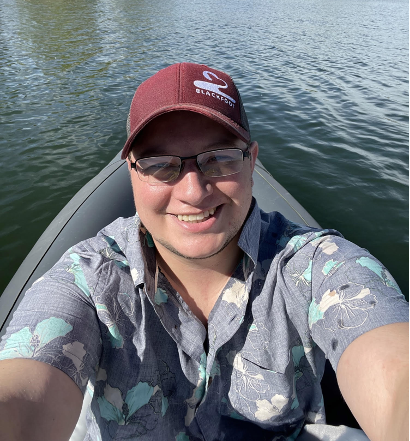
"After graduation, the passion and commitment I learned at Carroll took me in a very different direction than my chemistry degree. I entered the world of human rights and advocacy work. I started my academic experience at Carroll complaining about the required humanities and liberal arts classes, yet I have spent my career and my life depending on them.
"I started volunteering on LGBTQ rights (very nervously I might add) when I was a student at Carroll. I had lost a seasonal job after my employer discovered that I am a member of the LGBTQ community. It was the Carroll community that helped me find a different job on campus and helped me mourn the reality of discrimination and inequity in this world.
"Several years later, I committed to human rights work and advocacy after an 18-year-old attending a support group I ran died by suicide. They believed there was no place for them in this world because they were transgender. It reaffirmed how incredibly lucky I was to have the amount of support and love I had from the Carroll community while I was a student. Since then, I have committed myself to making sure all people regardless of gender identity, race, disability status, religion, veteran status, sexual orientation, or any other reason are able to be who they are and share the things they are passionate about with this world." ~ Shawn Reagor, Chemistry, Class of 2013
Shawn Reagor is the Director of Equality and Economic Justice at the Montana Human Rights Network. He and his spouse, Kasandra, live in Helena.
More articles can be found on the Alumni Successes chemistry webpage.
Copper Content of Moscow Mules Exceed EPA limits in 27 minutes!
The chemistry program at Carroll College is unique because, in addition to our numerous summer research opportunities, all of our students get to conduct research as part of the courses they take. As a result, our students graduate with the skills necessary to answer real-world research questions. These are highly desirable skills and they give our alumni an advantage in whatever post-college goals they pursue whether that be medical school, graduate school, chemical industry, or other employment opportunities.
A recent example of this research is our article, titled Quantifying the rate at which copper leaches from a copper drinking vessel into simulated beverages under conditions of consumer use, that was published in the January/February issue of the Journal of Environmental Health. The article has nine undergraduate co-authors who all contributed to this research as seniors in our senior-level course-based research experience, Integrated Lab. The cover art for the January/February issue of JEH was inspired by our article.
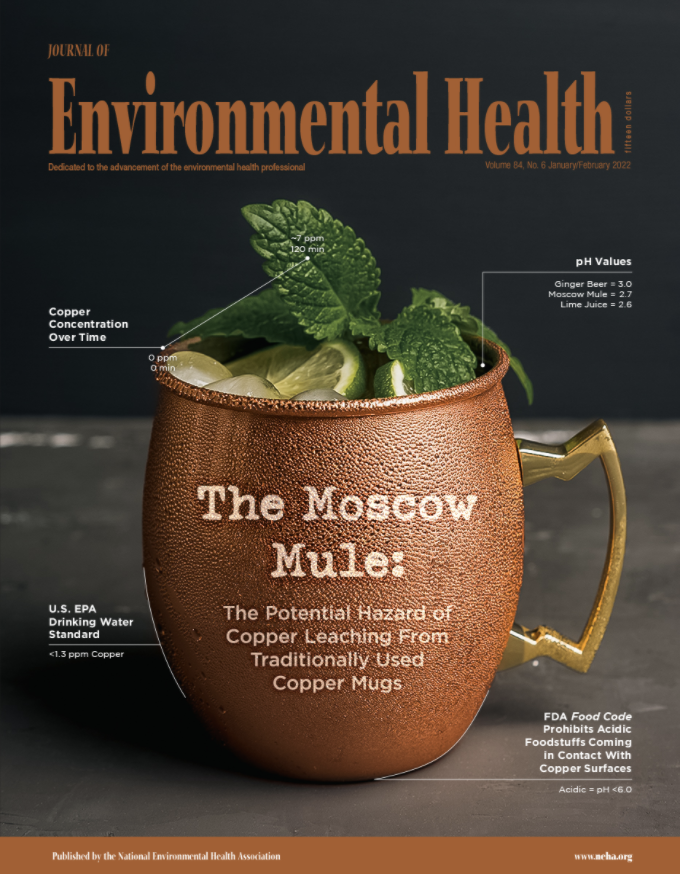
In the article we provide insight into the rate, total amount, and the chemical mechanism behind copper leaching from a copper surface into foodstuffs. Copper leaches into a Moscow Mule cocktail from the copper mug in which it is held at a rate that exceeds the EPA limit of 1.3 ppm in just over 27 minutes. The copper leaching was found to be dependent on the pH of the solution and the presence of dissolved oxygen.
“This research project is a great example of the fun and high-quality research that all of our chemistry students get to contribute to in our capstone Integrated Laboratory class” said Associate Chemistry Professor John Rowley. “The curriculum at Carroll College is unique because it is designed to allow all chemistry majors to master the ability to answer real-world questions that are multi-disciplinary, open-ended and loosely-defined.”
The Food and Drug Administration’s Model Food Code prohibits copper from being in direct contact with acidic foodstuffs that have a pH below 6.0. This article is a detailed study on the underlying chemistry that may motivate the FDA Model Food Code prohibitions on using copper in acidic conditions. Fortunately, any risk posed by the copper mug leaching is easily mitigated by using a mug lined on the interior with a material like stainless steel.
“I feel very lucky to have had the opportunity to work on this project as part of my classes and as a summer research student,” said Monika Weber, a Carroll 2017 graduate and co-author on the paper. “The skills and experience I gained from the chemistry program shaped me into the chemist I am today and allowed me to excel in my current role as a chemist at a metals testing lab.”
“The opportunity our students have to participate in research and make meaningful intellectual contributions gives them a huge advantage when applying to medical or graduate school,” said Associate Chemistry Professor Caroline Pharr. “Not only is it fun, but it also looks good on your resume to be an undergraduate co-author on a peer reviewed publication.” In addition to chemistry majors, all biology and biochemistry & molecular biology students also participate in course-based research experiences across the curriculum.
“Carroll’s motto is ‘Not for school but life’ and the science programs live this out by providing genuine research experiences for all of their majors,” said Dr. John Cech, president of Carroll College. “This commitment to providing transformative student experiences gives our graduates a clear advantage when applying to the competitive pre-professional programs they enter after graduating from Carroll College. We think this has a lot to do with Carroll College alumni having an 80% acceptance rate in medical schools and 100% acceptance rate to chemistry graduate schools.”
The success of the Moscow Mule research project is a result of the symbiotic relationship the chemistry faculty have created between their course-based research experiences (CURES) and summer/semester research experiences (SURES). Faculty have incorporated open-ended and real-world research problems into our courses across the chemistry curriculum. Students in these courses make meaningful contributions to the research projects. Often preliminary data and new knowledge is created by students enrolled in the course. This data and knowledge are then handed off to independent summer/semester research students. Outside the time constraints of a course, these independent semester/summer research students are able to gather the final publication quality data that we use for manuscripts like the Moscow Mule. The passing of data and knowledge from CURES to SURES (and vice versa) is a unique feature of the chemistry program at Carroll that connects all of our students into a program-wide learning community.
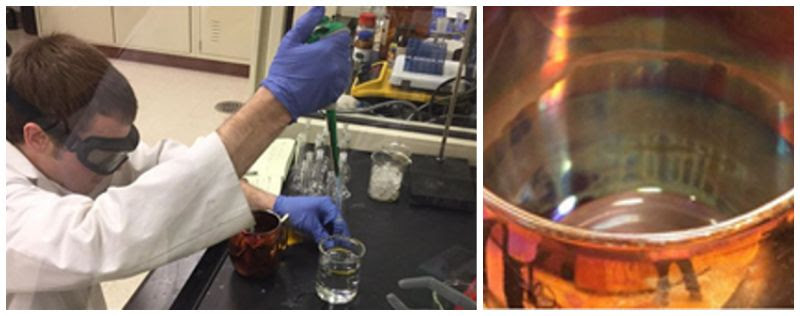
The chemistry department, in collaboration with the Office of Institutional Advancement (OIA), is working to create new endowed faculty chair positions to fund student research experiences like the ones that were essential for the Moscow Mule publication. The endowed faculty professorships will allow us to increase the number and quality of student research experiences we provide.
You can help provide these impactful opportunities for Carroll College students. To learn more about how you can support our efforts to create endowed faculty profess rships or help with other student scholarship opportunities, please contact Dr. Chris Aimone,Vice President for Institutional Advancement, at caimone@carroll.edu, 406-447-5528.
Welcome Professor Chrissie Carpenter
The chemistry department has grown over the past few years and we wanted to update you on the faculty you know and the faculty you may not yet have met. There are currently six chemistry faculty.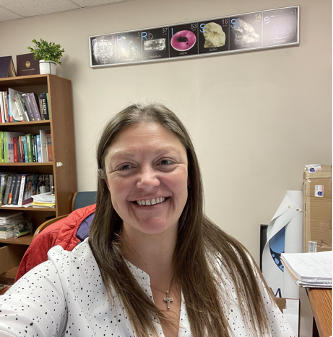 Professor Chrissie Carpenter joined the faculty at Carroll College in 2021 after teaching for 10 years at another institution. She is a 2002 Carroll graduate and is teaching biochemistry, chemistry for nursing students, and Integrated Lab.
Professor Chrissie Carpenter joined the faculty at Carroll College in 2021 after teaching for 10 years at another institution. She is a 2002 Carroll graduate and is teaching biochemistry, chemistry for nursing students, and Integrated Lab.
Her research in the Integrated Lab focuses on aqueous-based green chemistry involving naturally occurring carbohydrates and lipids. Professor Carpenter has served on the Montana Academy of Science for eight years and currently serves as President.
Professor Carpenter has brought “Fischer Fridays” to her classes where her trusty side-kick, a chocolate labrador, joins her in lecture and helps students relieve stress and learn chemistry.
Saints Giving Day - Help Support Professor Chrissie Carpenter's Research
You can help support the undergraduate research program of Professor Carpenter to investigate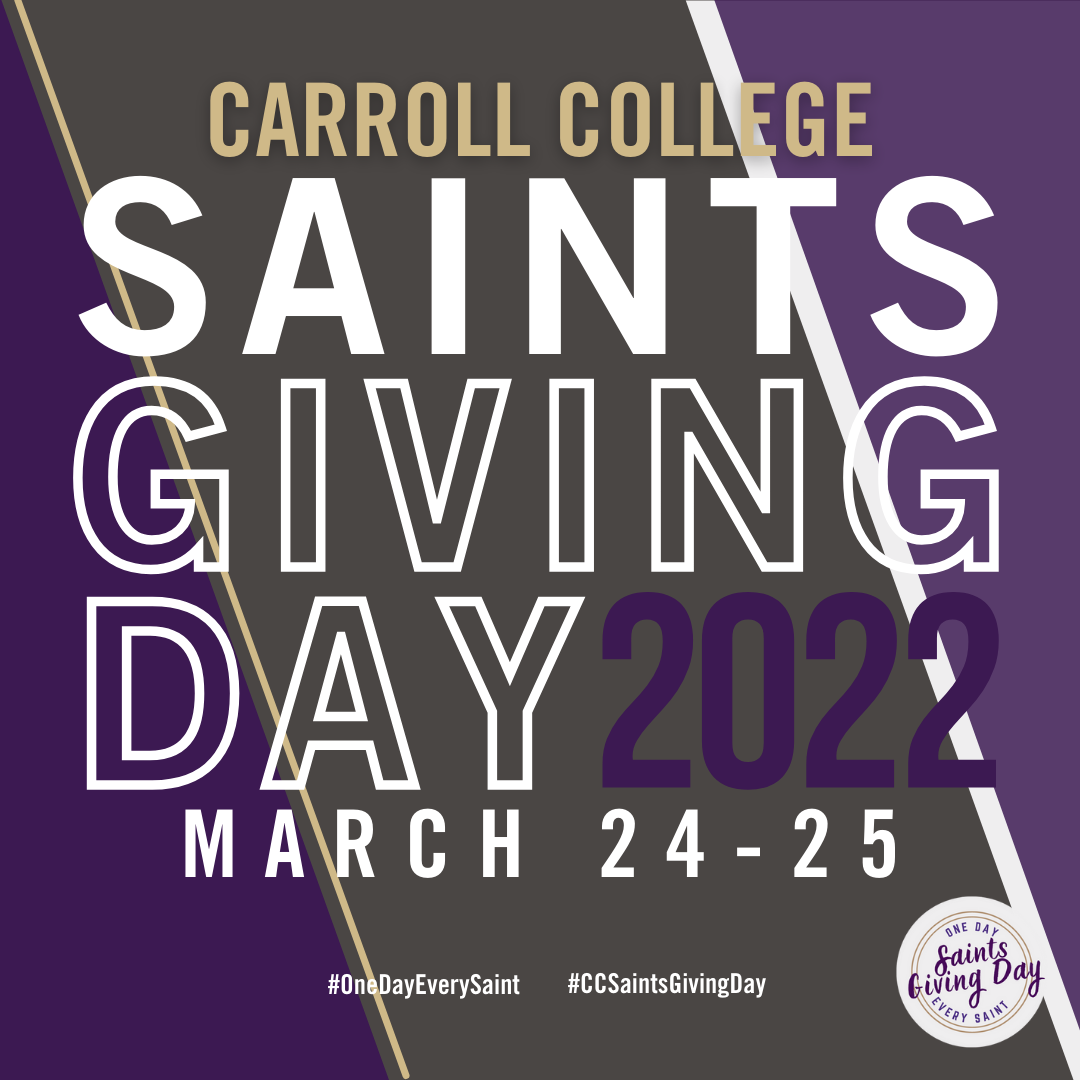 naturally occurring carbohydrates and lipids for use in aqueous-based green chemistry.
naturally occurring carbohydrates and lipids for use in aqueous-based green chemistry.
Professor Carpenter’s research program has been selected as one of the programs in the inaugural Carroll College “Saints Giving Day.” This fundraising campaign will last 24 hours starting at noon on Thursday the 24th of March. All of the funds raised for the chemistry department will go directly to supporting Professor Carpenter’s undergraduate research program. Click here to support Professor Carpenter’s research program.
Sign up to be a Saints Giving Day Ambassador for Professor Carpenter
What does being a Saints Giving Day Ambassador mean?
A Carroll College Saints Giving Day Ambassador is willing to help spread the word about Carroll's 2022 Giving Day and encourage others to make a gift during the 24-hour period. You can inspire your network in many ways, by sending emails, texts and using social media to share the causes you are passionate about. The success of Saints Giving Day and the funds raised can increase with each outreach you do!
Alright . . . you're in? Awesome! Becoming a Saints Giving Day Ambassador is easy.
- Fill out Ambassador Form at https://docs.google.com/
forms/d/e/1FAIpQLSdgxDFoLXU8_ aZ82TFg- AelEeFCNzqOGzOU9K9jPE23WojpPA/ viewform - Commit to sharing (through personal email and social media) Saints Giving Day messages before and during Saints Giving Day. We'll make this step easy with a timeline and toolkit provided. #CCSaintsGivingDay #OneDayEverySaint
- Commit to supporting your cause during Saints Giving Day, your gift (no matter the size) will start the momentum needed for this event.
- Watch your email for our Ambassador toolkit, including pictures and graphics you can use in your outreach.
Keeping Updated on News from the Chemistry Department
Did you miss our Fall 2021 Newsletter? Previous newsletters and press regarding the chemistry department can be found on our Chemistry News page. In addition, regular updates regarding our department can be found on our Instagram & Past Events page.
We are extremely grateful for the outreach and engagement we have seen from our alumni and supporters. Many of the transformative experiences we provide our students are made possible through your generosity. We also appreciate your feedback, insights, and ideas which are also important for the future success of our programs.
Please feel free to reach out to any of us via email and you can also follow us on Instagram @Carroll_College_Chemistry.
Sincerely,
The Carroll College Chemistry Faculty
